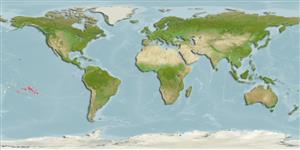Classification / Names
Nombres comunes | Sinónimos | Catalog of Fishes(Género, Especie) | ITIS | CoL | WoRMS | Cloffa
>
Eupercaria/misc (Various families in series Eupercaria) >
Labridae (Wrasses) > Cheilininae
Etymology: Oxycheilinus: Greek, oxys = sharp + Greek, cheilos = lip; lineatus: Name from Latin 'linea' for line, referring to the strong linear pattern..
More on authors: Randall, Westneat & Gomon.
Environment: milieu / climate zone / depth range / distribution range
Ecología
marino asociado a arrecife; rango de profundidad 49 - 85 m (Ref. 56651). Tropical
Distribución
Países | Áreas FAO | Ecosistemas | Ocurrencias, apariciones | Point map | Introducciones | Faunafri
Eastern Central Pacific: Rarotonga, Cook Islands and known from the Pitcairn Islands.
Tamaño / Peso / Age
Maturity: Lm ? range ? - ? cm
Max length : 16.0 cm SL macho / no sexado; (Ref. 56651)
Short description
Claves de identificación | Morfología | Morfometría
Espinas dorsales (total) : 9; Radios blandos dorsales (total) : 10; Espinas anales: 3; Radios blandos anales: 8; Vértebra: 23. This species is distinguished by the following characters: Dorsal rays IX, 10; anal rays III, 8; pectoral rays 13; lateral-line interrupted, with pored scales to caudal-fin base 16 + 7; gill rakers 4 + 8; body moderately elongate, with depth about 3.4 in SL; head length about 2.5 in SL; snout long and pointed, about 2.5 in head; dorsal profile of snout nearly straight, of nape slightly convex; lower jaw slightly projecting; maxilla ending a half-eye diameter before anterior margin of orbit; caudal fin (of adult male) slightly rounded, the upper 3 principal rays a little prolonged; membranes of spinous part of dorsal fin incised one-third to one-half length of spines; pectoral fins short, about 3.2 in head; body below lateral line with 12 narrow, slightly irregular, dark brown stripes separated by white lines; body above lateral line with
similar but more irregular bands; head with narrow dark brown bands radiating from eye except anteriorly; snout bluish gray with brown dots; a blackish blotch on basal half of first membrane of dorsal fin (Ref. 56651).
Occurs on deep reefs (Ref. 56651). Feeds on crustaceans and fishes (Ref. 89972).
Life cycle and mating behavior
Maturities | Reproducción | Spawnings | Egg(s) | Fecundities | Larva
Oviparous, distinct pairing during breeding (Ref. 205).
Randall, J.E., M.W. Westneat and M.F. Gomon, 2003. Two new labrid fishes of the genus Oxycheilinus from the South Pacific. Proc. Calif. Acad. Sci. 54(20):361-370. (Ref. 56651)
IUCN Red List Status (Ref. 130435)
Threat to humans
Harmless
Human uses
Herramientas
Special reports
Download XML
Fuentes de Internet
Estimates based on models
Preferred temperature (Ref.
123201): 13.3 - 16.4, mean 14.7 °C (based on 125 cells).
Phylogenetic diversity index (Ref.
82804): PD
50 = 0.5020 [Uniqueness, from 0.5 = low to 2.0 = high].
Bayesian length-weight: a=0.01585 (0.00707 - 0.03555), b=2.95 (2.76 - 3.14), in cm total length, based on LWR estimates for this (Sub)family-body shape (Ref.
93245).
Nivel trófico (Ref.
69278): 3.8 ±0.6 se; based on size and trophs of closest relatives
Resiliencia (Ref.
120179): Medio, población duplicada en un tiempo mínimo de 1.4-4.4 años (Preliminary K or Fecundity.).
Fishing Vulnerability (Ref.
59153): Low vulnerability (10 of 100).
Nutrients (Ref.
124155): Calcium = 79.7 [28.8, 182.6] mg/100g; Iron = 0.828 [0.305, 1.936] mg/100g; Protein = 18.5 [15.6, 20.7] %; Omega3 = 0.17 [0.09, 0.34] g/100g; Selenium = 29.9 [10.9, 90.5] μg/100g; VitaminA = 158 [47, 605] μg/100g; Zinc = 2.14 [0.93, 3.74] mg/100g (wet weight);
